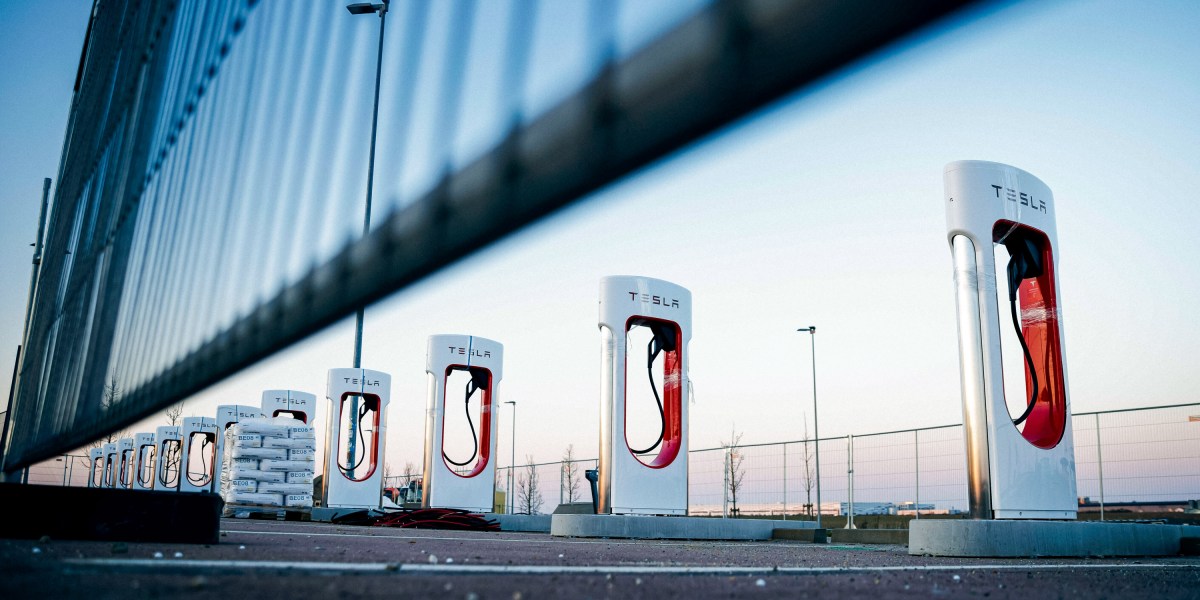Why EV charging needs more than Tesla
This article is from The Spark, MIT Technology Review’s weekly climate newsletter. To receive it in your inbox every Wednesday, sign up here.
Tesla, the world’s largest EV maker, laid off its entire charging team last week.
The timing of this move is absolutely baffling. We desperately need many more EV chargers to come online as quickly as possible, and Tesla has been a charging powerhouse. It’s in the midst of opening its charging network to other automakers and establishing its technology as the de facto standard in the US. Now, we’re already seeing new Supercharger sites canceled because of this move.
The charging meltdown at Tesla could slow progress on EVs overall, and ultimately, the whole situation shows why climate technology needs a whole lot more than Tesla.
Tesla first unveiled the Supercharger network in 2012 with six locations in the western US. As of 2024, the company operates over 50,000 Superchargers worldwide. (By the way, I want to note that I briefly interned at Tesla in 2016. I don’t have any ties to or financial interest in the company today.)
The Supercharger network helped make Tesla an EV juggernaut. Fast charging speeds and a navigation system that took the guesswork out of finding charging stations helped ease the transition for people buying their first EVs. Tesla operates more fast chargers than anyone else in the US, and the reliability of those chargers is leagues better than that of competitors. For a long time, this was all exclusive to Tesla drivers.
Over the past year, Tesla has begun cracking open the doors to its charging network. The company made some of its stations available to all EVs, in part to go after incentives designated for private companies building public chargers.
In the US, Tesla has also persuaded other automakers to adopt its charging connector, which it standardized and named the North American Charging Standard. In May 2023, Ford announced a move to adopt the NACS, and nearly every other automaker selling EVs in the US has followed suit.
Then, last week, Tesla laid off its 500-person charging team. The move came as part of wider layoffs that are expected to affect 10% of Tesla’s global workforce. Even interns weren’t immune.
Tesla “still plans to grow the Supercharger network,” though the focus will shift to maintaining and expanding existing locations rather than adding new ones, according to a post from CEO Elon Musk on the site formerly known as Twitter. (How does the company plan to expand or even maintain existing locations with apparently no dedicated charging team? Your guess is as good as mine. Tesla didn’t respond to a request for comment.)
But the effects from losing the charging team were immediate. Tesla backed out of a handful of leases for upcoming Supercharger locations in New York. In an email, the company told suppliers to hold off on breaking ground on new construction projects.
The move is a concerning one at a crucial time for EV charging infrastructure. Right now, there are nowhere near enough chargers installed in the US to support a shift to electric vehicles. If EVs make up half of new-car sales by the end of the decade, we’ll need roughly 1.2 million public chargers installed by then, according to a 2023 study from the National Renewable Energy Laboratory. Today, the country has 170,000 charging ports available.
In a recent poll, nearly 80% of US adults said that a lack of charging infrastructure is a primary reason for not buying an EV. That was true whether they lived in a city, in the suburbs, or in more rural areas.
In a way, it does make sense that Tesla appears to be uninterested in being the one to build out a public charging network. Chargers are costly to build and maintain, and they might not be all that profitable in the near term.
According to analysis by BNEF, Tesla pulled in about $1.7 billion from charging last year, only about 1.5% of the company’s total revenue. Opening up chargers to vehicles from other automakers could help push revenue from this source up to $7.4 billion annually by the end of the decade. But that’s still a relatively small piece of Tesla’s total potential pie.
Musk seems more interested in pursuing buzzy ideas like robotaxis than doing the difficult and expensive work of providing EV charging as a public service.
Honestly, I think this move is a wake-up call for the EV industry. Tesla has played an undeniable role in bringing EVs to the mainstream. But we’re in a new stage of the game now, one that’s less about sleek sports cars and more about deploying known technologies and keeping them working.
Other companies may step in to help fill the charging gap Tesla is opening. Revel expressed interest in taking over those canceled leases in New York City, for instance. But I wouldn’t hold my breath for a shiny new company to be our charging hero.
Cutting emissions and remaking our economy will require buckling down to deploy and maintain solutions that we already know work, whether that’s in transportation or any other sector. For EV charging, and for climate technology as a whole, we need more than Tesla. Here’s hoping we can get it.
Now read the rest of The Spark
Related reading
Perhaps the single biggest remaining barrier to EV adoption is a lack of charging infrastructure, as I wrote in a newsletter last year.
We need way more chargers to support the number of new EVs that are expected to hit the roads this decade. I dug into how many for a news story last year.
New battery technology could help EV batteries charge even faster. Learn what could be coming next in this story from August.
Another thing
Meat is a major climate problem. Whether solutions come in the form of plant-based alternatives or products grown in the lab, we shouldn’t expect them to solve every problem under the sun, argues my colleague James Temple, in a new essay published this week. Give it a read!
Keeping up with climate
Alternative jet fuels have a corn problem. The crop can be used to make fuels that qualify for tax credits in the US, but critics are skeptical about just how helpful they’ll be in efforts to cut emissions. (MIT Technology Review)
This startup is making fuel from carbon dioxide. Infinium’s Texas facility came online in late 2023, and its synthetic fuels could help clean up aviation and trucking—but only if the price is right. (Bloomberg)
New York City pizza shops are going electric. A citywide ordinance just went into effect that requires wood- and coal-burning ovens to cut their pollution, and many are turning to electric ovens instead of undertaking the costly upgrade. (New York Times)
Building a new energy system happens one project at a time. I loved this list of 10 potentially make-or-break projects that represent the potential future of our grid. (Heatmap)
→ The list includes a new site from Fervo in Utah, expected in 2026. Get the inside look at the company’s technology in this feature story from last year. (MIT Technology Review)
Funding for climate-tech startups in Africa is growing, with businesses raising more than $3.4 billion since 2019. But there’s still a long way to go to help the continent meet its climate goals. (Associated Press)
One very big, and very simple, thing is holding back heat pumps: a lack of workers. We need more people to make and install the appliances, which help cut emissions by using electricity to efficiently heat and cool spaces. (Wired)
→ Heat pumps are booming, and they’re on our list of 2024 Breakthrough Technologies. (MIT Technology Review)
Compressing air and storing it underground could help clean up the grid. Yes, really. Canadian company Hydrostor is close to breaking ground on its first large long-duration energy storage project later this year in Australia. (Inside Climate News)




